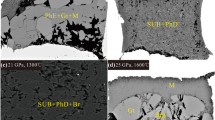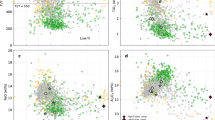Abstract
The stability of anhydrous phase B, Mg14Si5O24, has been determined in the pressure range of 14–21 GPa and the temperature range of 1100–1700 °C with both normal and reversal experiments using multi-anvil apparatus. Our results demonstrate that anhydrous phase B is stable at pressure–temperature conditions corresponding to the shallow depth region of the mantle’s transition zone and it decomposes into periclase and wadsleyite at greater depths. The decomposition boundary of anhydrous phase B into wadsleyite and periclase has a positive phase transition slope and can be expressed by the following equation: P(GPa) = 7.5 + 6.6 × 10−3 T (°C). This result is consistent with a recent result on the decomposition boundary of anhydrous phase B (Kojitani et al., Am Miner 102:2032–2044, 2017). However, our phase boundary deviates significantly from this previous study at temperatures < 1400 °C. Subducting carbonates may be reduced at depths > 250 km, which could contribute ferropericlase (Mg, Fe)O or magnesiowustite (Fe, Mg)O into the deep mantle. Incongruent melting of hydrous peridotite may also produce MgO-rich compounds. Anh-B could form in these conditions due to reactions between Mg-rich oxides and silicates. Anh-B might provide a new interpretation for the origin of diamonds containing ferropericlase–olivine inclusions and chromitites which have been found to have ultrahigh-pressure characteristics. We propose that directly touching ferropericlase–olivine inclusions found in natural diamonds might be the retrogressive products of anhydrous phase B decomposing via the reaction (Mg,Fe)14Si5O24 (Anh-B) = (Mg,Fe)2SiO4 (olivine) + (Mg,Fe)O (periclase). This decomposition may occur during the transportation of the host diamonds from their formation depths of < 500 km in the upper part of the mantle transition zone to the surface.




Similar content being viewed by others
References
Bercovici D, Karato S-i (2003) Whole-mantle convection and the transition-zone water filter. Nature 425:39–44
Bindi L et al (2016) Chromium solubility in anhydrous Phase B. Phys Chem Miner 43:103–110
Fei Y, Orman JV, Li J, Westrenen WV, Sanloup C, Minarik W, Hirose K, Komabayashi T, Walter M, Funakoshi K (2004) Experimentally determined postspinel transformation boundary in Mg2SiO4 using MgO as an internal pressure standard and its geophysical implications. J Geophys Res. https://doi.org/10.1029/2003JB002562
Finger L et al (1989) Crystal chemistry of phase B and an anhydrous analogue: implications for water storage in the upper mantle. Nature 341:140–142
Frost DJ et al (2004) Experimental evidence for the existence of iron-rich metal in the Earth’s lower mantle. Nature 428:409–412
Ganguly J, Frost DJ (2006) Stability of anhydrous phase B: experimental studies and implications for phase relations in subducting slab and the X discontinuity in the mantle. J Geophys Res Solid Earth 111:B06203
Ghosh S, Schmidt MW (2014) Melting of phase D in the lower mantle and implications for recycling and storage of H2O in the deep mantle. Geochim Cosmochim Acta 145:72–88
Griffin W et al (2016) Mantle recycling: transition zone metamorphism of Tibetan ophiolitic peridotites and its tectonic implications. J Petrol 57:655–684
Hayman PC et al (2005) Lower mantle diamonds from Rio Soriso (Juina area, Mato Grosso, Brazil). Contrib Miner Petrol 149:430–445
Hazen RM et al (1992) Crystal chemistry of Fe-bearing anhydrous phase B: implications for transition zone mineralogy. Am Miner 77:217–220
Herzberg C, Gasparik T (1989) Melting experiments on chondrite at high pressures: stability of anhydrous Phase B. Eos 70:484
Herzberg C, Zhang J (1996) Melting experiments on anhydrous peridotite KLB-1: compositions of magmas in the upper mantle and transition zone. J Geophys Res Solid Earth 101:8271–8295
Inoue T, Sawamoto H (1992) High pressure melting of pyrolite under hydrous condition and its geophysical implications. In: Syono Y, Manghnani MH (eds) High-pressure research: application to earth and planetary sciences. Terra, Tokyo and AGU, Washington, DC, pp 323–331
Ishii T et al (2015) High-pressure high-temperature transitions in MgCr2O4 and crystal structures of new Mg2Cr2O5 and post-spinel MgCr2O4 phases with implications for ultrahigh-pressure chromitites in ophiolites. Am Miner 100:59–65
Kato T, Kumazawa M (1985) Incongruent melting of Mg2SiO4 at 20 GPa. Phys Earth Planet Inter 41:1–5
Katsura T, Yamada H, Nishikawa O, Song M, Kubo A, Shinmei T, Yokoshi S, Aizawa Y, Yoshino T, Walter MJ, Ito E (2004) Olivine–wadsleyite transition in the system (Mg,Fe)2SiO4. J Geophys Res 109:B02209. https://doi.org/10.1029/2003JB002438
Katsura T, Yoneda A, Yamazaki D, Yoshino T, Ito E (2010) Adiabatic temperature profile in the mantle. Phys Earth Planet Inter 183:212–218
Kojitani H et al (2017) Experimental and thermodynamic investigations on the stability of Mg14Si5O24 anhydrous phase B with relevance to Mg2SiO4 forsterite, wadsleyite, and ringwoodite. Am Miner 102:2032–2044
Liebske C, Frost DJ (2012) Melting phase relations in the MgO–MgSiO3 system between 16 and 26 GPa: implications for melting in Earth’s deep interior. Earth Planet Sci Lett 345:159–170
Litasov K, Ohtani E (2002) Phase relations and melt compositions in CMAS–pyrolite–H2O system up to 25 GPa. Phys Earth Planet Inter 134:105–127
Litasov K, Ohtani E (2005) Phase relations in hydrous MORB at 18–28 GPa: implications for heterogeneity of the lower mantle. Phys Earth Planet Inter 150:239–263
Litasov K et al (2001) Melting relations of hydrous pyrolite in CaO–MgO–Al2O3–SiO2–H2O System at the transition zone pressures. Geophys Res Lett 28:1303–1306
Martirosyan N et al (2016) The CaCO3–Fe interaction: kinetic approach for carbonate subduction to the deep Earth’s mantle. Phys Earth Planet Inter 259:1–9
McCammon C (1997) Perovskite as a possible sink for ferric iron in the lower mantle. Nature 387:694–696
Melekhova E et al (2007) The composition of liquids coexisting with dense hydrous magnesium silicates at 11–13.5 GPa and the endpoints of the solidi in the MgO–SiO2–H2O system. Geochimica et cosmochimica acta 71:3348–3360
Mibe K et al (2002) Composition of aqueous fluid coexisting with mantle minerals at high pressure and its bearing on the differentiation of the Earth’s mantle. Geochim Cosmochim Acta 66:2273–2285
Morishima H et al (1994) The phase boundary between α-and β-Mg2SiO4 determined by in situ X-ray observation. Science 265:1202–1203
Ohtani E et al (1995) Melting relations of peridotite and the density crossover in planetary mantles. Chem Geol 120:207–221
Ohtani E, Suzuki A, Kato T (1998) Flotation of olivine and diamond in mantle melt at high pressure: implications for fractionation in the deep mantle and ultradeep origin of diamond. In: Manghnani MH, Yagi T (eds) Properties of Earth and planetary materials at high pressure and temperature. Geophysical monograph, vol 101. American Geophysical Union, Washington DC, 227–239
Ohtani E et al (2001) Stability of dense hydrous magnesium silicate phases and water storage capacity in the transition zone and lower mantle. Phys Earth Planet Inter 124:105–117
Ottonello G et al (2010) Thermo-chemical and thermo-physical properties of the high-pressure phase anhydrous B (Mg14Si5O24): an ab-initio all-electron investigation. Am Miner 95:563–573
Palyanov YN et al (2013) Mantle–slab interaction and redox mechanism of diamond formation. Proc Natl Acad Sci 110:20408–20413
Ringwood A, Major A (1967) High-pressure reconnaissance investigations in the system Mg2SiO4–MgO–H2O. Earth Planet Sci Lett 2:130–133
Rohrbach A, Schmidt MW (2011) Redox freezing and melting in the Earth/’s deep mantle resulting from carbon-iron redox coupling. Nature 472:209–212
Rohrbach A et al (2007) Metal saturation in the upper mantle. Nature 449:456–458
Smith EM et al (2016) Large gem diamonds from metallic liquid in Earth’s deep mantle. Science 354:1403–1405
Stachel T et al (2000) Kankan diamonds (Guinea) II: lower mantle inclusion parageneses. Contrib Miner Petrol 140:16–27
Stalder R et al (2001) High pressure fluids in the system MgO–SiO2–H2O under upper mantle conditions. Contrib Miner Petrol 140:607–618
Suzuki A et al (2000) In situ determination of the phase boundary between wadsleyite and ringwoodite in Mg2SiO4. Geophys Res Lett 27:803–806
Xiong F et al (2015) Origin of podiform chromitite, a new model based on the Luobusa ophiolite, Tibet. Gondwana Res 27:525–542
Yang J-S et al (2007) Diamond-and coesite-bearing chromitites from the Luobusa ophiolite. Tibet Geology 35:875–878
Zhang Y et al (2013) Phase transitions of harzburgite and buckled slab under eastern China. Geochem Geophys Geosyst 14:1182–1199
Zhang Y et al (2016) Experimental constraints on the fate of subducted upper continental crust beyond the “depth of no return”. Geochim Cosmochim Acta 186:207–225
Acknowledgements
E.O. acknowledges the financial support from the Japan Society for the Promotion of Science (No. 15H05748). A.S. acknowledges the financial support from the Ministry of Education, Science, Sports and Culture, Grant-in-Aid for Scientific Research on Innovative Areas (15H05826, 15H05828, and 15K21712). Z.J. thanks the financial support from the National Natural Science Foundation of China (41174076). L.Y. is supported by the International Joint Graduate Program in Earth and Environmental Science (GP-EES), Tohoku University. D.F. acknowledges DFG funding of the International Research and Training Group “Deep Volatile Cycles”.
Author information
Authors and Affiliations
Corresponding author
Electronic supplementary material
Below is the link to the electronic supplementary material.
Rights and permissions
About this article
Cite this article
Yuan, L., Ohtani, E., Shibazaki, Y. et al. The stability of anhydrous phase B, Mg14Si5O24, at mantle transition zone conditions. Phys Chem Minerals 45, 523–531 (2018). https://doi.org/10.1007/s00269-017-0939-5
Received:
Accepted:
Published:
Issue Date:
DOI: https://doi.org/10.1007/s00269-017-0939-5




